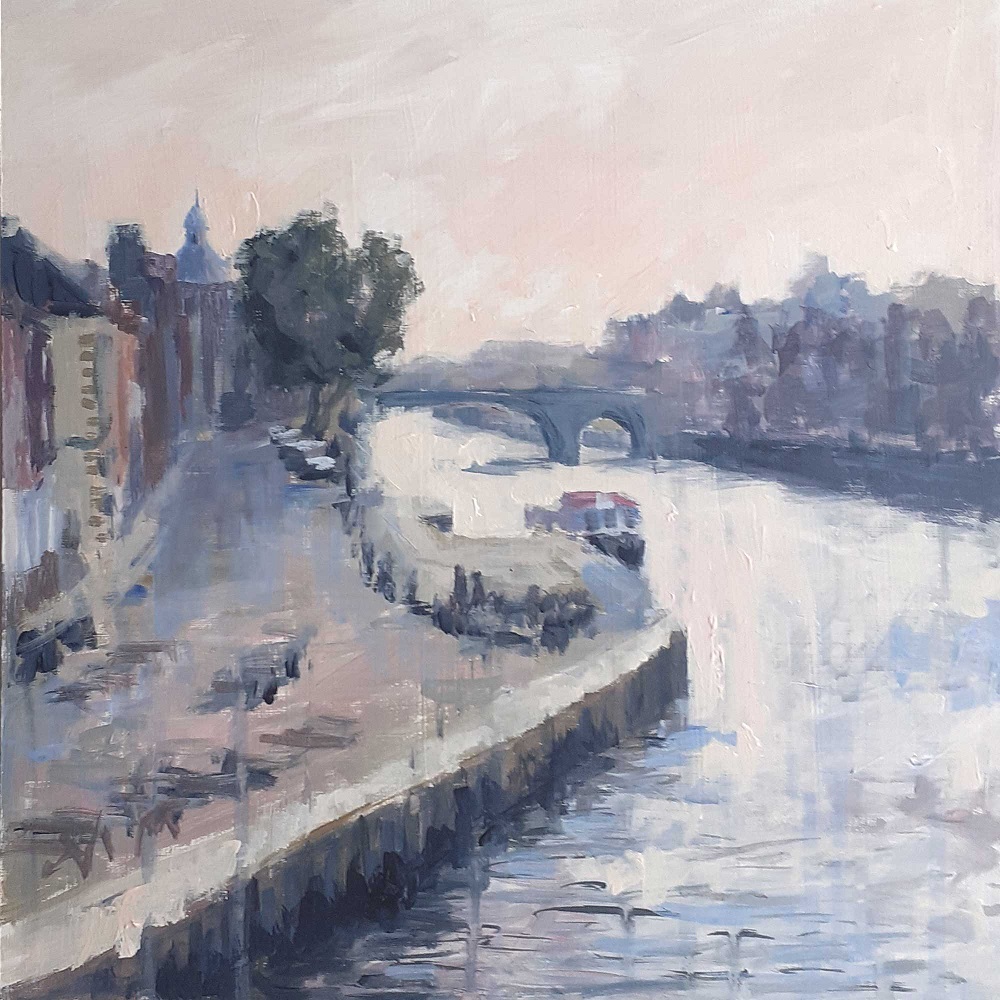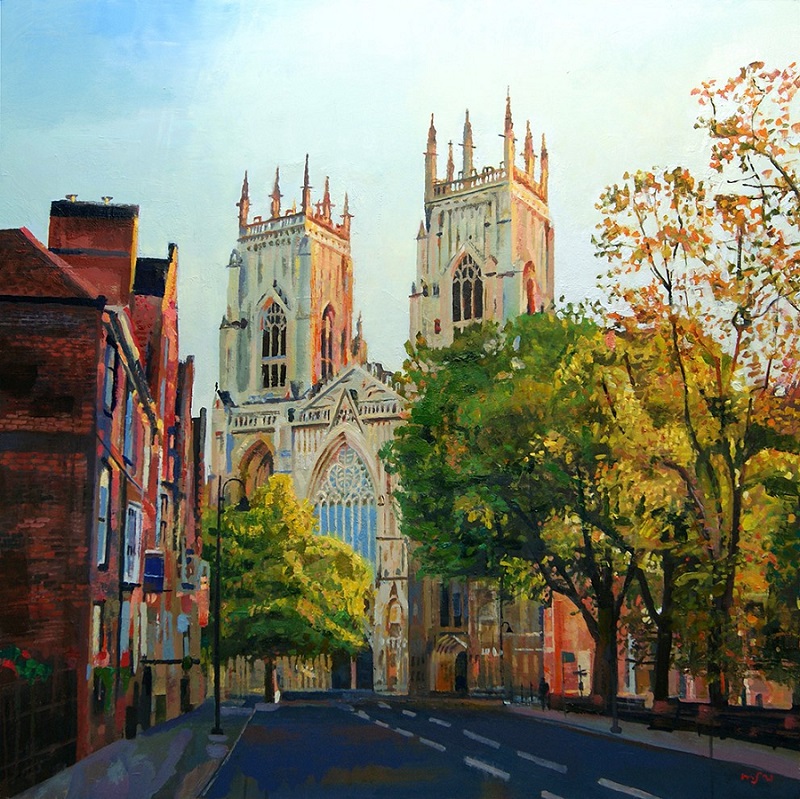
BLUE Tree Gallery, in Bootham, York, is reopening with Covid-secure measures and temporary opening hours of 11am to 5pm on Tuesdays, Thursdays and Saturdays.
The York 2021 exhibition, marking the tenth anniversary of Gordon Giarchi and Marisa Giarchi launching the gallery on March 23 2011, began online on March 27, with the works “also displayed in the gallery and gallery window for those passing by”.
York 2021, featuring original paintings by Sarah Connell, Giuliana Lazzerini, Paolo Lazzerini and Mark Sofilas, will run until May 8, now both in person and at bluetreegallery.co.uk.
“With the support of our exhibiting artists, and especially our supportive clients, exposure in the media and grants assistance from City of York Council, we continue with the gallery and now see a light ahead through this pandemic,” say Gordon and Marisa.
Manchester mixed-media landscape artist Sarah Connell’s paintings are “primarily about light, atmosphere and colour”. “I have painted in traditional media ever since I can remember, but now also paint digitally, using a stylus and tablet at a computer or on an iPad,” she says.
“My parents are both creative and encouraged me as a child by buying me ‘grown-up’ paints, and sometimes my dad let me tag along with his night school art class. The fact he was a printer meant there was always paper by the ream for me to draw on.”

Sarah then read Art History and Archaeology at Nottingham University, followed by Clothing Design at Manchester Metropolitan University. “It was while studying clothing design that I first became interested in digital painting and wrote my dissertation on analogue versus digital fashion illustration,” she recalls.
“In a way, I am still exploring how traditional painting influences my digital work and vice versa. I went on to work in design and photography for a few companies, eventually going freelance and spending more and more time painting.”
Blue Tree Gallery artist-in-residence Giuliana Lazzerini was born in Seravezza, near the small town of Pietrasanta, in Tuscany, the daughter of a professional painter and international mosaicist.
Between 1962 and 1968, she was a student at the Istituto d’Arte Stagio Stagi in Pietrasanta, gaining a Master of Arts Diploma, and then studied painting at the Accademia di Belle Arti di Carrara for four years.
In 1987, Giuliana moved to Yorkshire, where she now lives in York. The Tuscan landscape and childhood memories still bear a strong influence on her work, her first encounters with art in Italy having been in her painter father Bruno’s mosaic studio.
Both the translucency of the mosaic fragments and the vibrancy and colours evoked by the juxtaposed mosaic pieces inspired her.
These early perceptions, several years on, provide a language and a vocabulary for her pictures in terms of the colours, surfaces and scale that she uses in constructing her tapestry-like, interlocking, angular-surfaced village landscapes.

Architecture exists within a shallow space; structures are locked together through a medieval, narrative sort of pictorial logic.
In other works, Giuliana depicts solitary portrait images. Figures often appear with props, such as shells, cups and boats, and equestrian references sometimes appear too. Are these characters the inhabitants of Lazzerini’s interlocking Tuscan villages, or part of some ceremonial ritual?
“My work is varied and often developed from an idea encountered during a journey that takes me in an unknown territory where I grow as an artist,” says Giuliana. “I usually work in small series of paintings, where memory and imagination come to interplay. Time made me more familiar with the English northern landscape and it finally has left a mark in some of my work, as I become more intrigued by its drama and atmosphere.”
Giuliana’s brother, Paolo Lazzerini, trained at the Liceo Artistico and the Accademia delle Belle Arti in Carrara, winning numerous art prizes and being invited to exhibit in important galleries such as the Accademia of Santa Cecilia in Rome, Le Tableau Gallery in Turin, Galleria San Marco of Rome, Ponte Tresa Gallery in Switzerland and Gallery 2000 in Tokyo, Japan.
Although Paolo worked primarily as a professional graphic designer in the 1990s and 2000s, he continued to paint, presenting many solo and mixed exhibitions in Italy at Forte Dei Marmi, Turin, Edinburgh, Yorkshire, Birmingham, Monaco and Cologne. In the past few years, Paolo’s painting has become more intense, on show at many more events and exhibitions.
Mark Sofilas, originally from Western Australia, migrated to Great Britain in 2008. “I was an illustrator with more than 20 years’ experience in the advertising industry but took the opportunity, on moving to the UK, to turn to fine art, something that I had always wanted to do,” he says.
He now paints full time from his studio in Leeds, creating oil paintings of the Yorkshire countryside, particularly coastal scenes of the heritage coast, such as the fishing villages of Whitby, Staithes and Robin Hood’s Bay.

“My paintings are very heavily guided by the emotions a particular scene or moment evokes in me. It’s this feeling that I try to convey to the viewer,” says Mark, a proud member of Leeds Fine Artists and the Association of British Naive Artists.
“It might be something as simple as smoke drifting from a chimney pot or a silhouette created by a particular light source. It may be the strength or history that emanates from an everyday object or piece of architecture.”
Over time, Mark has discovered he can best achieve emotional impact by exaggerating or characterising colour, manipulating perspective slightly and pushing shape and form to arrive, hopefully, at a “nicely balanced place”, where the image conjured has not only captured the physical qualities of the scene, but more importantly, the feeling of the occasion.
“I’m a self-taught painter; not locked into approaching my work with any particular procedure or direction in mind,” he says. “However, I take photographs of my subjects, but like to rely on memory, imagination, the ultimate goal being to recreate exactly what I’m feeling onto a flat surface.
“I don’t do preliminary drawings. Instead, I prefer to adopt a more organic approach, designing the paintings as I go. This helps the end product retain a freshness, a feeling of spontaneity. I always have an image, a mood in my mind’s eye, that I’m trying to put down, and I find that working this way allows me to be flexible; going with any happy accidents that more than likely will occur.”
Mark adds: “It’s these little surprises that I can adopt, learn from and take into my next painting. I enjoy the journey that this direct and unstructured approach takes me on, finding that it enables me to either get close to achieving what I had in mind and heart or, on occasion, arrive somewhere unexpected but just as rewarding.”
